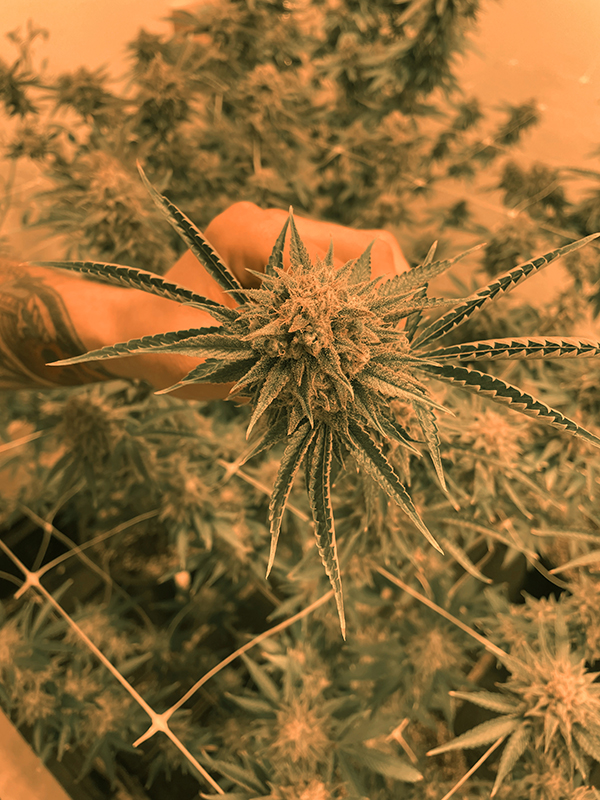By KAYLEA BROWN, LANEY COOK AND DEVYN LANDSEN Northwestern News
Oklahoma has dirt as red as its politics. But in 2018, voters gave the green light to medical marijuana. The people who peddle the plant have become big economic players in small towns across the state — including Alva.
Flashback to Sept. 4, 2019.
On the lawn of the Woods County Courthouse in Alva, protesters rallied against a city ordinance that created restrictions on medical marijuana establishments.
Residents from across the state traveled in buses to transport Alva residents with their medical marijuana cards to another town to get the medicine they needed.
Now, almost two years later, four dispensaries and 13 growing facilities have made their home in Alva. The worries people had about medical marijuana are no longer as extreme as they once were.
People can have their medical cards for various reasons. But it is still an issue Northwestern students face if they live on campus and want to have and use medicinal marijuana.
Students can face a variety of consequences if they are caught on campus with marijuana, but the punishment is not as severe as if they were caught without the medical license.
Northwestern Oklahoma State University Chief of Alva Campus Police Kyle Hair explained what would happen to students if they got caught with marijuana on campus.
“If they have a medical card, it’s usually just going to be an administrative fine [from the housing department] … and it can go further,” Hair said.
NWOSU is one of many universities in Oklahoma that receives funding from the federal government. This means that, as long as marijuana remains federally illegal in all forms, it will not be allowed on college campuses.
UNIVERSITY AND CITY POLICIES
The university has not seen a major increase in the use of marijuana since legalization, officials said. Hair said the only way to catch students with the drug is by detecting the smell of it being smoked, and by hearing complaints from roommates or resident assistants in dormitory halls.
Students without medical cards are more easily caught in instances of smoking. In such cases, the students may receive an administrative fine, but criminal charges are also possible.
Possession of marijuana without a medical card is still considered a misdemeanor in Oklahoma, leading to the possibility of a fine. It is only taken this far if it becomes a recurring problem in the dorms and/or on campus.
Hair said that, unless a complete legalization of marijuana across the board occurs, it will not be allowed anywhere on campus.
From the housing department’s point of view, the legalization of medical marijuana has changed possession of marijuana into a campus conduct matter rather than a law enforcement matter.
“There haven’t been problems, but there have been very few isolated incidents,” said Matt Adair, assistant dean of students and director of housing at NWOSU. “Since I’ve been in the job, [there’s been] a fairly good run of kids who have chosen not to break the rules or bring illegal substances to campus.”
Changing this to a conduct matter means that students get into more trouble with the school, but not as much trouble with the city in terms of tickets.
Adair said the federal government classifies marijuana as a Schedule One narcotic. This means that marijuana is considered a drug that has no known medical use that is accepted and has a high potential of abuse, according to narcotics.com.
Since the legalization of marijuana, the campus has had few incidents, and the same can be said for the city.
Woods County Sheriff Rudy Briggs Jr. said he has had no trouble with the dispensaries in town and is unaware of any increase in problems since medical marijuana was legalized. Dr. Bo Hannaford, an Alva city councilman holding the Ward 3, Seat 1 office, said the legalization has impacted some businesses around town.
“I think that [it’s] hurt some of our businesses because they can’t get people into some of the jobs because they can’t pass a drug test,” Hannaford said.
Several businesses in Alva have policies that require employees to be able to pass a drug test in order to not only start a job, but also to keep a job. NWOSU is one such employer.
ALVA DISPENSARIES
Four dispensaries are in Alva. The newest one, Healing Hope, is on Oklahoma Boulevard and opened in March.
According to Oklahoma.gov, the owner of a dispensary is required to fill out several applications and meet certain requirements before starting a business.
Some of the requirements and applications are renewal applications. If the business already has a business license and submits the application before its license is expired, then it will remain valid through the renewal process.
Another requirement is proof of residency in the town in which the business will operate. Owners have to prove they’ve been residents of the town for two years.
Medical marijuana businesses cannot be within 1,000 feet of a public or private school. This does not include daycares or child care facilities. The owner has to have a background check, fill out a disclosure form and meet other requirements.
Julie Melton, the owner of the dispensary Alvatraz Cannabis Company on The Square, said the city has been supportive of her business. Melton said she sells to about 300 different people, and her most popular products are female cannabis plants, which are called “flower.”
Flower is the most popular form because it is the most versatile product and can be smoked in a bong or pipe. It can also be rolled in a joint or blunt, she said.
Melton said the strain she has sold the most of is named “Golden Goat,” which helps patients with depression, she said. She said she has more of that strain than any other.
“What you can sell is just dictated by what you have access to,” Melton said. “You only have available to you what the growers have grown.”
Iggy’s Green Rush, south of town on Highway 281, is owned by Chris Penoyer. He opened one of the first dispensaries in Cherokee in 2018. After the first dispensary opened in Alva, Joint Pains, Penoyer decided to open a store in Alva because a majority of his customers drove from this area to his Cherokee location. He said he knew his store in Cherokee would not survive with the new dispensary in Alva.
“I knew eventually there would be more dispensaries in the future, so I decided to put a store here as quickly as possible,” Penoyer said.
Penoyer said someone attempted to break into his store in Alva, but the person didn’t steal anything. The perpetrator was not caught on camera.
On a monthly basis, he’ll make about 300 sales, he said. Flower and THC vapes are his store’s most popular items. The cheapest item sold at Iggy’s is a gram of flower, which is sold for $14. The next cheapest is a gram of concentrate, which is sold for $40. Concentrate is a substance that comes from the hairs of a flower called trichome glands.
Shannon Corbitt owns Joint Pains, which is on the corner of Oklahoma Boulevard and Noble Street in Alva. The store has another location at 1521 Main St. in Waynoka.
Corbitt was the first to open a dispensary in Alva. He said it took a while to build the town’s trust. He said he has a lot of problems with rumors and hearsay in Alva. But in Waynoka, he said “no one cares” and that the town is “laid back.”
Corbitt said about 50 to 75 people come through the door each day. He sells several pre-rolls, which are the cheapest products he sells, for about $5. The most expensive item is one gram of concentrate, sold for about $50.
Dispensaries have a limit on how much they can sell to a customer at a time, and the requirements are listed on the back of a person’s medical marijuana card. The limit is 3 ounces of flower, an ounce of concentrate and 72 ounces of edibles. Users are allowed to buy all of it at once, but they can only have 3 ounces on their person at a time.
GROWING FACILITIES
In the two years since Oklahoma legalized medical marijuana, 7,283 growing facilities have popped up in the state.
Nineteen are in Woods County, and 13 are right outside Alva’s city limits, according to the Oklahoma Medical Marijuana Authority.
Under Oklahoma law, at least 75% of a growing-facility operation must be owned by people who have been Oklahoma residents for two to five years. Growers are allowed to sell products to dispensaries, other growers and processors.
Each growing facility must pay a $2,500 fee per license type to become a licensed grower. The renewal fee each year is also $2,500.
Devin Hamlin, owner of Green Med Cannabis Co., said he started a growing facility as soon as medical marijuana was legalized. He started from scratch and built a new building north of Alva.
Hamlin said the process of becoming a licensed grower was confusing at first.
“They (state officials) passed all these laws and everything, and they really didn’t have a set rulebook,” Hamlin said.
“Everybody was just doing everything, and people were getting in trouble because [of] the way the state wrote the laws. It wasn’t anybody’s fault except the state’s.”
The regulations are now clearer, and the system is less chaotic, Hamlin said.
In September 2020, the Oklahoma Medical Marijuana Authority partnered with Metrc, a seed-to-sale track-and-trace regulatory system. This system tracks marijuana plants from the time they’re seeds to the point at which they’re purchased by consumers at dispensaries. All plants have to have barcodes as soon as they are planted, and these barcodes track the plant’s entire life cycle.
“I think it’s more them [the state] trying to keep it away from people just growing it and then selling it on the street illegally,” Hamlin said.
A plant needs about nine months to grow from a seed into a flower. However, the practice of cloning only takes about three to four months.
The cloning process involves cutting a branch off a live marijuana plant. That branch will then grow into its own plant. Because clones take a shorter amount of time to grow, the process helps facilities start up their businesses. It also helps during times when the demand for products is higher.
Hamlin said the new Metrc system that goes into effect April 30 is expensive. It costs 45 cents per barcode, and he said he’ll need about 2,000 barcodes for all of his plants. The cost to have a license is now about $10,000 with all the extra costs, he said.
Hamlin said only 10 growing facilities operate in Arkansas because it costs $100,000 a year to have a growing license there. Because Oklahoma has more growing facilities, the competition is harder in places such as Oklahoma City. This means products are sold cheaper.
Typically, dispensaries buy flower by either quarters or pounds from growers. Hamlin said he sold 30 pounds of his strain, “Citral Glue,” to just one dispensary on one of his deliveries in March.
Hamlin has a high percentage of THC in his Citral Glue strain: 39% THC. He said he can sell this strain for a maximum of $3,500 per pound. Usually, though, he sells it at a rate between $2,200 and $2,400 per pound.
This price drops in Oklahoma City, where the average sale price ranges from $1,600 to $1,800 per pound. But sometimes, it drops even lower.
“Some people will do anything to sell it and even go as cheap as $200 to $300 per pound,” he said.
CARD HOLDER’S VIEWPOINT
As of March 5, Oklahoma has more than 381,000 patients or caregivers with medical marijuana cards, meaning 9.5% of the state’s population is able to buy marijuana.
To get a medical marijuana card, a person must be an Oklahoma resident and show proof of residency. The OMMA application fee is $100, but if the patient qualifies for Medicaid or Medicare, the fee is reduced to $20.
The Northwestern News spoke to one cardholder who chose to remain anonymous for medical reasons. The person said obtaining a medical marijuana card is not difficult.
“I got my card because I have sciatica and it flares up sometimes,” the person said. “But really, I just like it because it helps me sleep at night.”
The person said the pain management marijuana offers is top-tier.
As a cardholder, a person is allowed to have up to 8 ounces of marijuana in their residence at a time. The cardholder said some good regulations exist, but the fact that one person can have that much marijuana is excessive.
“I feel like no one is ever going to need that much [marijuana] on them, and if they do, then they’re probably selling it on the side illegally,” the person said.



